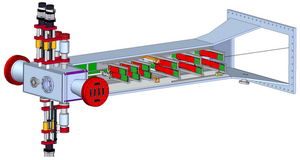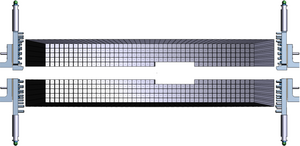The HPS Run Wiki
The printable version is no longer supported and may have rendering errors. Please update your browser bookmarks and please use the default browser print function instead.
[edit]
HPS 2016 run, February 4 to March 14, weekends only.
Shifts are manned from Friday 12pm to 7am on Monday.
Beam energy 2.3 GeV (1 pass).
Important: Document all your work in the logbook!
Spring 2015 Final @ 1 GeV:
Phone NumbersShift ScheduleShift-Taker's ChecklistHot CheckoutBeam Time AccountingHPS Run Spreadsheet |
Procedures
|
Manuals |
JLab Logbooks
|
RC: Stepan Stepanyan (Bluejeans info for Run Meetings on Thursdays and Fridays at 3pm)
- (757) 575-7540
- 9 575 7540 from Counting Room
PDL: Harut Avagyan
Run Plan for February 5 - 7, 2016:Locking up the hall
Bringing beam to the hall (consult with RC with any problem):
Miscellaneous Notes:
|
General Instructions:Recovering from beam trips when running SVT at 0.5 mm:
Every Shift:
Every Run:
Setting up Chicane for E=2.3 GeV:Note: This requires Beam Permit and NO beam to HPS / Faraday Cup.
SVT Instructions:
ECAL Instructions:
Acceptable Beam Conditions:
|
|
|
| ||||||||||||||||||||||||||||||||||||||||||||||||||||||||||||||||||||||||||
.
|
Webcams:
|
Accelerator: |
Slow Controls:
|
Online & Offline: |
| System/Person | Pager/Phone Number |
|---|---|
| Run Coordinator | (757) 575-7540 (cell) |
| Physics Div. Liaison | (757) 876-1789 (cell) |
| MCC-OPS | 7048 |
| Crew Chief | 7045 |
| Crew Chief | 9-879-3367 (cell) |
| Program Deputy | 9-876-7997 (cell) |
| Gate House Guard | 5822 |
| DAQ/Online | (757) 869-2188 (cell) |
| SVT | (757) 541-7539 (cell) |
| ECAL | (757) 810-1489 (cell) |
| Slow Controls | (757) 748-6922 (cell) |
| Beamline | (757) 303-3996 (cell) |
| Engineering | (757) 748-5048 |
| Hall-B Floor | 5165 |
| Hall-B Space Frame | 5170, 5171 |
| Hall-B Forward Carriage | 5371 |
| Hall-B Counting Room | 5126, 5244, 5246, 5247 |
| Hall-B Gas Shed | 7115 |


